Will Dyson
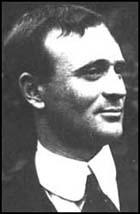
Will Dyson, the ninth of eleven children, was born in Australia in 1880. Will's father, George Dyson was a miner in the Australian and was active in the local Labor Party. So were his older brothers, and two of them, Ted and Ambrose, contributed articles and drawings for a socialist paper called The Champion. Will Dyson was taught to draw by his brothers and in 1900 he began having cartoons published in the Sydney Bulletin.
During the next few years he became a regular contributor to the Sydney Bulletin, with conservative politicians being the main target for his satire. He developed a reputation as a talented cartoonist and in 1904 he was offered a job as a staff artist for the Adelaide Critic.
In 1909 Dyson moved to London and immediately found work with the Weekly Dispatch. This was a time of great political excitement in Britain with the Liberal government challenging the powers of the House of Lords and the Women's Social and Political Union using militant methods to win the vote.
It was also a time of industrial conflict with a large number of strikes. As a socialist, Will Dyson supported the attempts by the trade unions to increase their members wages. In December 1910 Dyson contributed cartoons to The World, a strike sheet produced by London printers. In January 1911 this strike sheet was renamed the Daily Herald. The first issue of 13,000 copies sold out. Over the next few weeks sales continued to increase.
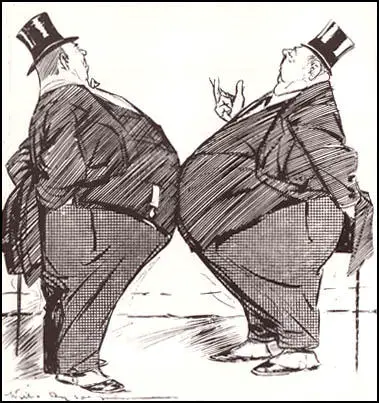
ECONOMIC DARWINISM
Right Thinking Person: "The visionaries and Socialist demagogues may rant against
us, my boy, but they can't alter the divine law of the Survival of the Fattest!"
Mark Bryant has pointed out: "He (Dyson) worked at great speed, using mostly brush and ink but also pen and litho crayon on cartridge paper." Martin Walker, the author of Daily Sketches: A Cartoon History of Twentieth Century Britain (1978), has argued: "Dyson's main hate was the capitalist class, and though his genius and fury could hurt them, the deepest wounds were suffered by the Labour Party, then as now too timid and too law-abiding to satisfy Dyson's passions."
When the strike ended in April the printers stopped publishing their newspaper. However, the striking printers had shown that there was a market for a left-wing newspaper and several leaders of the labour movement, including George Lansbury and Ben Tillett, joined together to raise the necessary funds.
The Daily Herald reappeared on 15th April, 1912, and Will Dyson was recruited as the newspaper's cartoonist. His editor, Charles Lapworth, gave him a full page and complete freedom on how to fill it. Dyson's cartoons created a sensation. He was acclaimed by one critic as the best cartoonist seen in Britain since James Gillray.
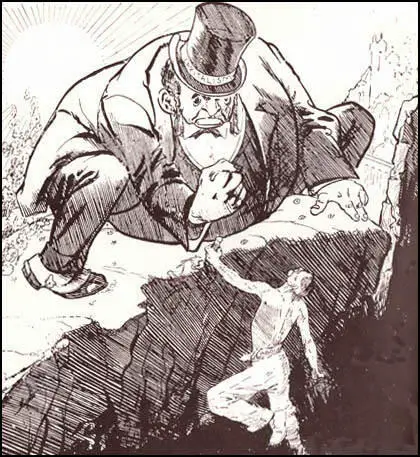
LABOUR WANTS A "PLACE IN THE SUN"!
CAPITAL (deeply shocked at Labour's efforts to emerge): "Back to
your abyss, Sir! As it is already there is scarcely enough sun to go round!"
As one critic pointed out, the cartoons of Will Dyson "featured boldly drawn figures representing clear symbols of the noble, wronged worker verses brutal, evil employers." Some Labour politicians believed that Dyson was going too far with some of his cartoons. George Lansbury, a socialist and a Christian, complained when Dyson portrayed capitalist as devils.
Other progressives were worried when his drawings began to attack the Labour Party for not being radical enough. Ramsay MacDonald, the leader of the party, was a particular target of Dyson's scorn. At a joint conference in October 1912, the TUC and the Labour Party decided to give their support to another newspaper, The Daily Citizen.
The newspaper fully supported the actions of the women fighting for the vote. Dyson agreed with this policy. In his native Australia, women had the vote since 1893. Dyson felt very strongly about this issue and produced a series of cartoons attacking the way the government was treating the suffragettes.
Sometimes they were so powerful that the editor of the Daily Herald decided to let Dyson's drawings take over the whole of the front page. This included a cartoon published on 24th May showing showing Reginald McKenna, the Home Secretary, force-feeding a suffragette (see below).
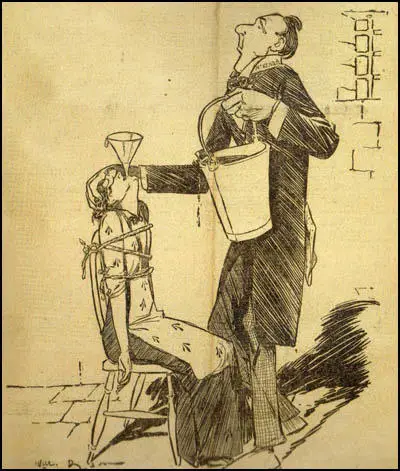
In June, 1913, at the most important race of the year, the Derby, Emily Wilding Davison ran out on the course and attempted to grab the bridle of Anmer, a horse owned by King George V. The horse hit Emily and the impact fractured her skull and she died without regaining consciousness. Although many suffragettes endangered their lives by hunger strikes, Emily Davison was the only one who deliberately risked death. However, her actions did not have the desired impact on the general public. They appeared to be more concerned with the health of the horse and jockey and Davison was condemned as a mentally ill fanatic. However, Will Dyson published a cartoon in the Daily Herald in support of her actions.
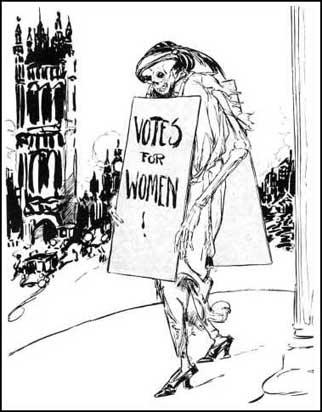
Whereas newspapers usually condemned strikers, the Daily Herald encouraged workers to take industrial action. As one critic pointed out, Dyson's cartoons "featured boldly drawn figures representing clear symbols of the noble, wronged worker verses brutal, evil employers." Some Labour politicians believed that Dyson was going too far with some of his cartoons.
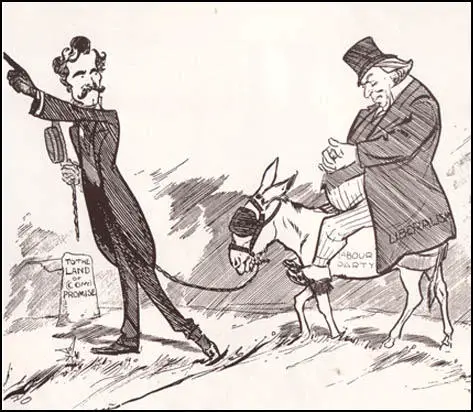
ON THE WAY TO NOWHERE
Ramsay MacDonald (leading the Labour Party into the Land of Compromise):
"Forward, my four-footed brother, forward, and in spite of all they say, let us
continue to take advantage, in the devilish diplomatic way we are at
present doing, of the fact that the Old Party is going in the same direction!"
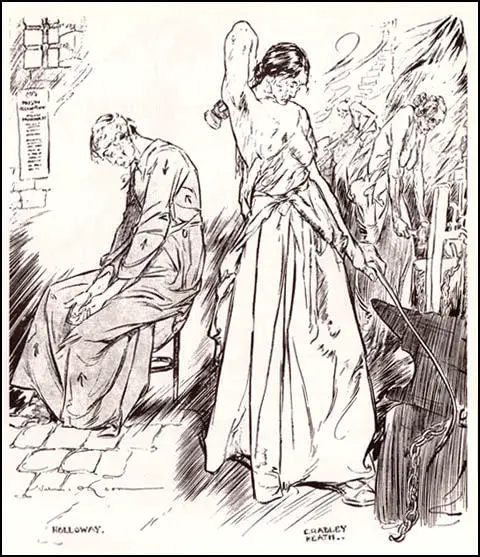
UNWOMANLY (Holloway) WOMANLY (Cradley Heath)
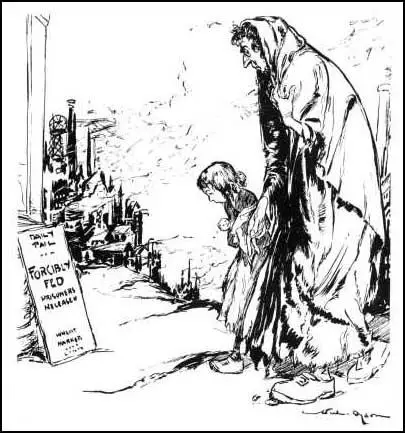
Will Dyson, The Daily Herald (1914)
Will Dyson was extremely popular with the public and even conservative newspapers tried to recruit him. When the First World War was declared in July 1914, the Daily Herald denounced it as the product of capitalism and militarism. Dyson also detested war but thought that he had a duty to defend those people in Belgium and France being attacked by the Germans. Dyson joined the army and despite being wounded twice, he produced a large number of drawings of Australian soldiers in battle.
In One of the old platoon (1917) "An Australian soldier pauses at a wooden cross marking the final resting place of a fallen comrade, whose helmet rests on top. Between 1916 and 1918 Australians on the Western Front wore the British issue Brodie pattern steel helmet as head protection while in the trenches. The soldier's isolation and that of the grave are heightened by Dyson's use of the low horizon against which both are silhouetted."
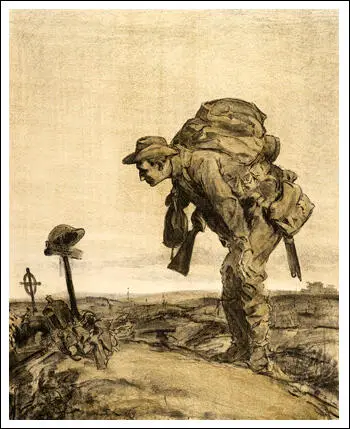
Dyson's most powerful drawing during the First World War is German Prisoners captured at Ypres (1918). Dyson shows compassion towards the wounded German prisoners. Dyson knew personally of the horrors experienced by the soldiers on both sides and was wounded twice. His friend Charles Bean, the official correspondent, wrote that no "other official artist saw a tenth part as much of the real Western Front as did Will Dyson.".
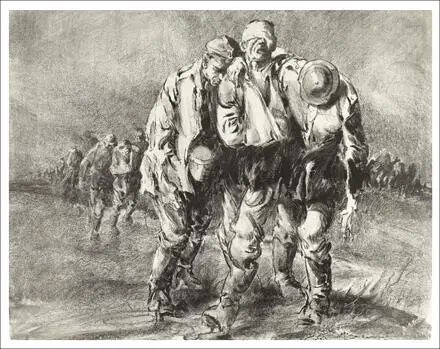
As soon as the war was finished Dyson returned to the Daily Herald. His first cartoon in the newspaper showed David Lloyd George, the Prime Minister, standing by a badly wounded soldier shouting: "You've won, you've won, my brave and incomparable fellow - vote for me." In the 1918 General Election Will Dyson not only used his cartoons to help the Labour Party, he also drew and designed several of their posters.
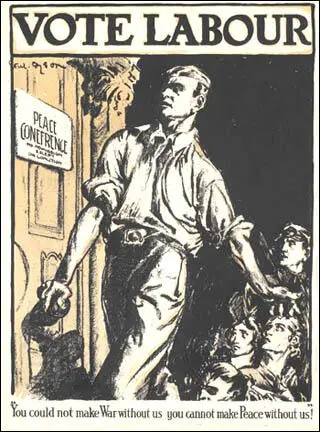
You could not make War without us you cannot make Peace without us! (1918)
On 12th March, 1919, Dyson's wife Ruby died, a victim of the influenza pandemic that swept the world after the war. Dyson was devastated and suffered a mental breakdown. He was unable to work for some time but returned in May and produced his most famous cartoon, Peace and Future Cannon Fodder, where he predicted that the Versailles Treaty would lead to a Second World War.
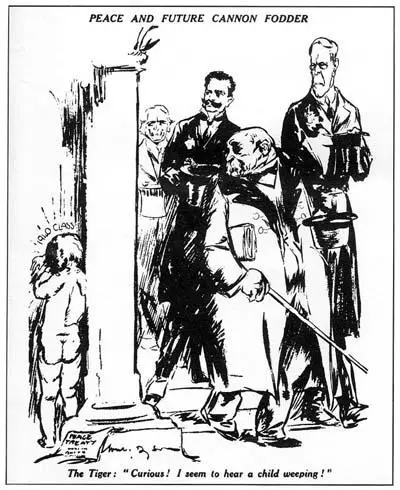
G. K. Chesterton called Dyson "the most original and penetrating artist of our time." The cartoonist, John Jensen, added: "Stylistically Dyson had few imitators - his work was too complex - but the power of his ideas brought back to British cartooning the strong flavour and impact of a Gillray after years of Victorian politeness."
The cartoonist, David Low, was deeply influenced by the work of Will Dyson: "Will, despite his sadness, was a great comfort in the cheerless winter of 1919-20. From his early Bulletin days I had been his great admirer as one of the master caricaturist-cartoonists. Will Dyson had broken up the pattern with his striking Socialist cartoons in the Herald from about 1910 onward, and had led the field during the First World War with his large war cartoons in which the monumental and the satirical had been powerfully blended."
After the war Dyson became disillusioned with the Daily Herald. In an attempt to attract advertising the paper became more moderate in its political views. In July 1921 Dyson left the newspaper. Dyson had some of his cartoons published in other newspapers but he was seen by most editors as far too radical.
In 1925 he decided to return to Australia. He was employed by the Melbourne Punch but now in his forties, his cartoons lacked the passion of his pre-war work.
Will Dyson died on 21st January, 1938.
Primary Sources
(1) David Low found it difficult to adjust to life in London when he arrived in 1919. Will Dyson was one of first friends he made in England.
I had just left the warmth of a wide circle of friends in Australia to come to this desert island. The contrast was painful. "It will take you ten years to learn the English," said Will Dyson, the Australian cartoonist, whom we found crouching over a sinking fire in a large dark studio, nursing a great grief at the death of his wife.
Will, despite his sadness, was a great comfort in the cheerless winter of 1919-20. From his early Bulletin days I had been his great admirer as one of the master caricaturist-cartoonists. Will Dyson had broken up the pattern with his striking Socialist cartoons in the Herald from about 1910 onward, and had led the field during the First World War with his large war cartoons in which the monumental and the satirical had been powerfully blended.
(2) Margaret Cole, like Will Dyson, contributed to the Daily Herald during the First World War.
Dyson was a brilliant biting Australian cartoonist, whose sharp pencil attacked alike financiers, profiteering employers, "safe" Labour and Trade Union leaders, and German military men, with a bitterness unknown in British caricature since Gillray.

